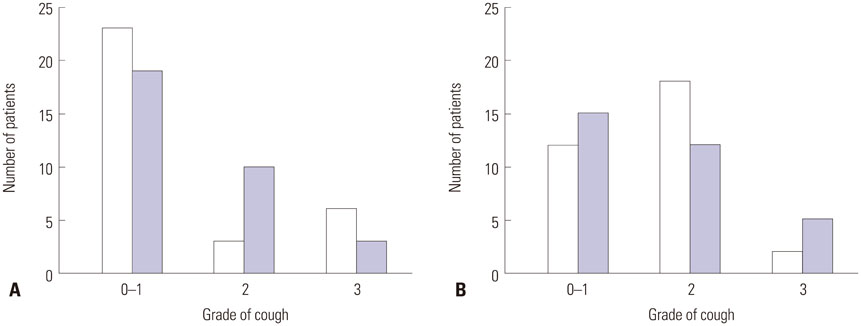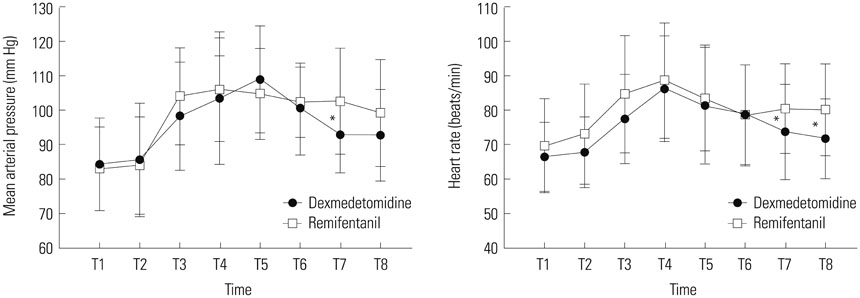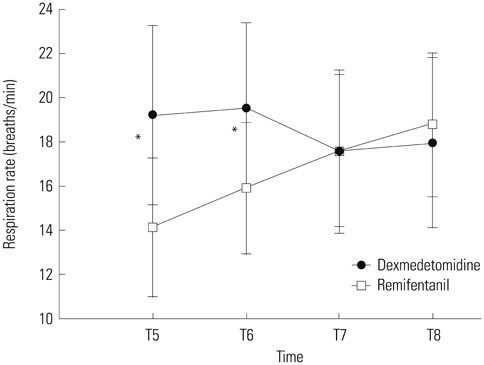Yonsei Med J.
2016 Jul;57(4):980-986. 10.3349/ymj.2016.57.4.980.
Comparison of Dexmedetomidine and Remifentanil on Airway Reflex and Hemodynamic Changes during Recovery after Craniotomy
- Affiliations
-
- 1Department of Anesthesiology and Pain Medicine, Kangdong Sacred Heart Hospital, Hallym University College of Medicine, Seoul, Korea.
- 2Department of Anesthesiology and Pain Medicine, Yonsei University College of Medicine, Seoul, Korea. csho99@yuhs.ac
- 3Anesthesia and Pain Research Institute, Yonsei University College of Medicine, Seoul, Korea.
- KMID: 2374133
- DOI: http://doi.org/10.3349/ymj.2016.57.4.980
Abstract
- PURPOSE
During emergence from anesthesia for a craniotomy, maintenance of hemodynamic stability and prompt evaluation of neurological status is mandatory. The aim of this prospective, randomized, double-blind study was to compare the effects of dexmedetomidine and remifentanil on airway reflex and hemodynamic change in patients undergoing craniotomy.
MATERIALS AND METHODS
Seventy-four patients undergoing clipping of unruptured cerebral aneurysm were recruited. In the dexmedetomidine group, patients were administered dexmedetomidine (0.5 µg/kg) for 5 minutes, while the patients of the remifentanil group were administered remifentanil with an effect site concentration of 1.5 ng/mL until endotracheal extubation. The incidence and severity of cough and hemodynamic variables were measured during the recovery period. Hemodynamic variables, respiration rate, and sedation scale were measured after extubation and in the post-anesthetic care unit (PACU).
RESULTS
The incidence of grade 2 and 3 cough at the point of extubation was 62.5% in the dexmedetomidine group and 53.1% in the remifentanil group (p=0.39). Mean arterial pressure (p=0.01) at admission to the PACU and heart rate (p=0.04 and 0.01, respectively) at admission and at 10 minutes in the PACU were significantly lower in the dexmedetomidine group. Respiration rate was significantly lower in the remifentanil group at 2 minutes (p<0.01) and 5 minutes (p<0.01) after extubation.
CONCLUSION
We concluded that a single bolus of dexmedetomidine (0.5 µg/kg) and remifentanil infusion have equal effectiveness in attenuating coughing and hemodynamic changes in patients undergoing cerebral aneurysm clipping; however, dexmedetomidine leads to better preservation of respiration.
MeSH Terms
-
Adult
Aged
Airway Extubation
*Anesthesia Recovery Period
Cough/drug therapy
*Craniotomy/adverse effects
Dexmedetomidine/*pharmacology/therapeutic use
Double-Blind Method
Female
Hemodynamics/*drug effects
Humans
Male
Middle Aged
Piperidines/*pharmacology/therapeutic use
Prospective Studies
Reflex/*drug effects
Respiratory System/blood supply/*drug effects/physiopathology
Young Adult
Dexmedetomidine
Piperidines
Figure
Cited by 1 articles
-
Comparison of Dexmedetomidine and Fentanyl as an Adjuvant to Ropivacaine for Postoperative Epidural Analgesia in Pediatric Orthopedic Surgery
Sang Jun Park, Seokyung Shin, Shin Hyung Kim, Hyun Woo Kim, Seung Hyun Kim, Hae Yoon Do, Yong Seon Choi
Yonsei Med J. 2017;58(3):650-657. doi: 10.3349/ymj.2017.58.3.650.
Reference
-
1. Leech P, Barker J, Fitch W. Proceedings: changes in intracranial pressure and systemic arterial pressure during the termination of anaesthesia. Br J Anaesth. 1974; 46:315–316.
Article2. Irwin RS. Complications of cough: ACCP evidence-based clinical practice guidelines. Chest. 2006; 129:1 Suppl. 54S–58S.3. Gefke K, Andersen LW, Friesel E. Lidocaine given intravenously as a suppressant of cough and laryngospasm in connection with extubation after tonsillectomy. Acta Anaesthesiol Scand. 1983; 27:111–112.
Article4. Mendel P, Fredman B, White PF. Alfentanil suppresses coughing and agitation during emergence from isoflurane anesthesia. J Clin Anesth. 1995; 7:114–118.
Article5. Minogue SC, Ralph J, Lampa MJ. Laryngotracheal topicalization with lidocaine before intubation decreases the incidence of coughing on emergence from general anesthesia. Anesth Analg. 2004; 99:1253–1257.
Article6. Lee B, Lee JR, Na S. Targeting smooth emergence: the effect site concentration of remifentanil for preventing cough during emergence during propofol-remifentanil anaesthesia for thyroid surgery. Br J Anaesth. 2009; 102:775–778.
Article7. Jun NH, Lee JW, Song JW, Koh JC, Park WS, Shim YH. Optimal effect-site concentration of remifentanil for preventing cough during emergence from sevoflurane-remifentanil anaesthesia. Anaesthesia. 2010; 65:930–935.
Article8. Lee JH, Koo BN, Jeong JJ, Kim HS, Lee JR. Differential effects of lidocaine and remifentanil on response to the tracheal tube during emergence from general anaesthesia. Br J Anaesth. 2011; 106:410–415.
Article9. Nho JS, Lee SY, Kang JM, Kim MC, Choi YK, Shin OY, et al. Effects of maintaining a remifentanil infusion on the recovery profiles during emergence from anaesthesia and tracheal extubation. Br J Anaesth. 2009; 103:817–821.
Article10. Chen J, Li W, Wang D, Hu X. The effect of remifentanil on cough suppression after endoscopic sinus surgery: a randomized study. Acta Anaesthesiol Scand. 2010; 54:1197–1203.
Article11. Guler G, Akin A, Tosun Z, Ors S, Esmaoglu A, Boyaci A. Single-dose dexmedetomidine reduces agitation and provides smooth extubation after pediatric adenotonsillectomy. Paediatr Anaesth. 2005; 15:762–766.
Article12. Tufanogullari B, White PF, Peixoto MP, Kianpour D, Lacour T, Griffin J, et al. Dexmedetomidine infusion during laparoscopic bariatric surgery: the effect on recovery outcome variables. Anesth Analg. 2008; 106:1741–1748.
Article13. Tanskanen PE, Kyttä JV, Randell TT, Aantaa RE. Dexmedetomidine as an anaesthetic adjuvant in patients undergoing intracranial tumour surgery: a double-blind, randomized and placebocontrolled study. Br J Anaesth. 2006; 97:658–665.
Article14. Bekker A, Sturaitis M, Bloom M, Moric M, Golfinos J, Parker E, et al. The effect of dexmedetomidine on perioperative hemodynamics in patients undergoing craniotomy. Anesth Analg. 2008; 107:1340–1347.
Article15. Turgut N, Turkmen A, Ali A, Altan A. Remifentanil-propofol vs dexmedetomidine-propofol--anesthesia for supratentorial craniotomy. Middle East J Anaesthesiol. 2009; 20:63–70.16. Gunduz M, Gunes Y, Ozbek H, Yilmaz D, Isik G. Comparison of dexmedetomidine or remifentanil infusion combined with sevoflurane anesthesia in craniotomy: hemodynamic variables and recovery. Neurosurg Q. 2009; 19:116–119.
Article17. Minto CF, Schnider TW, Egan TD, Youngs E, Lemmens HJ, Gambus PL, et al. Influence of age and gender on the pharmacokinetics and pharmacodynamics of remifentanil. I. Model development. Anesthesiology. 1997; 86:10–23.
Article18. Alon E, Baitella L, Hossli G. Double-blind study of the reversal of midazolam-supplemented general anaesthesia with Ro 15-1788. Br J Anaesth. 1987; 59:455–458.
Article19. Kapila A, Glass PS, Jacobs JR, Muir KT, Hermann DJ, Shiraishi M, et al. Measured context-sensitive half-times of remifentanil and alfentanil. Anesthesiology. 1995; 83:968–975.
Article20. Guy J, Hindman BJ, Baker KZ, Borel CO, Maktabi M, Ostapkovich N, et al. Comparison of remifentanil and fentanyl in patients undergoing craniotomy for supratentorial space-occupying lesions. Anesthesiology. 1997; 86:514–524.
Article21. Sneyd JR, Whaley A, Dimpel HL, Andrews CJ. An open, randomized comparison of alfentanil, remifentanil and alfentanil followed by remifentanil in anaesthesia for craniotomy. Br J Anaesth. 1998; 81:361–364.
Article22. Lee JS, Choi SH, Kang YR, Kim Y, Shim YH. Efficacy of a single dose of dexmedetomidine for cough suppression during anesthetic emergence: a randomized controlled trial. Can J Anaesth. 2015; 62:392–398.
Article23. Venn RM, Bradshaw CJ, Spencer R, Brealey D, Caudwell E, Naughton C, et al. Preliminary UK experience of dexmedetomidine, a novel agent for postoperative sedation in the intensive care unit. Anaesthesia. 1999; 54:1136–1142.
Article24. Hsu YW, Cortinez LI, Robertson KM, Keifer JC, Sum-Ping ST, Moretti EW, et al. Dexmedetomidine pharmacodynamics: part I: crossover comparison of the respiratory effects of dexmedetomidine and remifentanil in healthy volunteers. Anesthesiology. 2004; 101:1066–1076.25. Ebert TJ, Hall JE, Barney JA, Uhrich TD, Colinco MD. The effects of increasing plasma concentrations of dexmedetomidine in humans. Anesthesiology. 2000; 93:382–394.
Article26. Cold GE, Felding M. Even small doses of morphine might provoke "luxury perfusion" in the postoperative period after craniotomy. Neurosurgery. 1993; 32:327.
Article27. Feld JM, Hoffman WE, Stechert MM, Hoffman IW, Ananda RC. Fentanyl or dexmedetomidine combined with desflurane for bariatric surgery. J Clin Anesth. 2006; 18:24–28.
Article28. Zhuang PJ, Wang X, Zhang XF, Zhou ZJ, Wang Q. Postoperative respiratory and analgesic effects of dexmedetomidine or morphine for adenotonsillectomy in children with obstructive sleep apnoea. Anaesthesia. 2011; 66:989–993.
Article29. Kim SY, Kim JM, Lee JH, Song BM, Koo BN. Efficacy of intraoperative dexmedetomidine infusion on emergence agitation and quality of recovery after nasal surgery. Br J Anaesth. 2013; 111:222–228.
Article30. Kavalci G, Ethemoglu FB, Durukan P, Batuman A, Emre C. Comparison of the effects of dexmedetomidine and remiphentanyl on emergence agitation after sevoflurane anesthesia in adults undergoing septoplasty operation: a randomized double-blind trial. Eur Rev Med Pharmacol Sci. 2013; 17:3019–3023.31. Bloor BC, Ward DS, Belleville JP, Maze M. Effects of intravenous dexmedetomidine in humans II Hemodynamic changes. Anesthesiology. 1992; 77:1134–1142.32. Dyck JB, Maze M, Haack C, Vuorilehto L, Shafer SL. The pharmacokinetics and hemodynamic effects of intravenous and intramuscular dexmedetomidine hydrochloride in adult human volunteers. Anesthesiology. 1993; 78:813–820.
Article33. Choi SH, Min KT, Lee JR, Choi KW, Han KH, Kim EH, et al. Determination of EC95 of remifentanil for smooth emergence from propofol anesthesia in patients undergoing transsphenoidal surgery. J Neurosurg Anesthesiol. 2015; 27:160–166.
Article34. Catley DM, Thornton C, Jordan C, Lehane JR, Royston D, Jones JG. Pronounced, episodic oxygen desaturation in the postoperative period: its association with ventilatory pattern and analgesic regimen. Anesthesiology. 1985; 63:20–28.
- Full Text Links
- Actions
-
Cited
- CITED
-
- Close
- Share
- Similar articles
-
- Anesthetic management of awake craniotomy with laryngeal mask airway and dexmedetomidine in risky patients
- Comparison of Remifentanil-Propofol and Remifentanil-Sevoflurane Anesthesia for Pediatric Tonsillectomy
- Efficacy of intraoperative dexmedetomidine infusion on visualization of the surgical field in endoscopic sinus surgery
- Comparison of dexmedetomidine and remifentanil for attenuation of hemodynamic responses to laryngoscopy and tracheal intubation
- Hemodynamic Response and Recovery Profile of Remifentanil Anesthesia in Pediatric Strabismus Surgery




